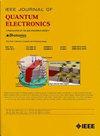A Design Approach for a Homogeneous Hole-Assisted Multi-Core Fiber Through Hole-Allocation Around the Central Core for Minimizing Crosstalk
IF 2.2
3区 工程技术
Q3 ENGINEERING, ELECTRICAL & ELECTRONIC
引用次数: 0
Abstract
In this paper, a new design of seven-core hole-assisted multi-core fiber with surrounding each core is presented. Here, the holes are assumed to be filled with materials having very low refractive index contrast with cladding. Coupling of light from the central core to the outer cores of seven-core structure is investigated by rotating the holes in the range +30° to −30° around the central core. The optimum range of angles for which coupling is very low is estimated for different values of core-pitch. An average value of crosstalk and power penalty are then calculated from the minimum coupling region for core pitch一种均匀孔辅助多芯光纤的设计方法,通过中心芯周围的孔分配来减少串扰
本文提出了一种新的七芯孔辅助多芯光纤的设计方案。在这里,孔洞被假定用与包层相比折射率非常低的材料填充。通过在中心核周围+30°到- 30°范围内旋转孔,研究了七芯结构中芯到外芯的光耦合。在不同的芯距值下,估计了耦合极低的最佳角度范围。然后计算串扰和功率损失的平均值,从核心间距$40~\mu \text{m}$到$45~\mu \text{m}$的最小耦合区域,其中串扰低于阈值限制(取为- 30dB)。在此基础上建立了分析模型,结果与仿真结果吻合较好。所提出的优化设计对于提高基于空分复用的低串扰和低功耗应用的容量和效率非常有帮助。
本文章由计算机程序翻译,如有差异,请以英文原文为准。
求助全文
约1分钟内获得全文
求助全文
来源期刊

IEEE Journal of Quantum Electronics
工程技术-工程:电子与电气
CiteScore
4.70
自引率
4.00%
发文量
99
审稿时长
3.0 months
期刊介绍:
The IEEE Journal of Quantum Electronics is dedicated to the publication of manuscripts reporting novel experimental or theoretical results in the broad field of the science and technology of quantum electronics. The Journal comprises original contributions, both regular papers and letters, describing significant advances in the understanding of quantum electronics phenomena or the demonstration of new devices, systems, or applications. Manuscripts reporting new developments in systems and applications must emphasize quantum electronics principles or devices. The scope of JQE encompasses the generation, propagation, detection, and application of coherent electromagnetic radiation having wavelengths below one millimeter (i.e., in the submillimeter, infrared, visible, ultraviolet, etc., regions). Whether the focus of a manuscript is a quantum-electronic device or phenomenon, the critical factor in the editorial review of a manuscript is the potential impact of the results presented on continuing research in the field or on advancing the technological base of quantum electronics.
 求助内容:
求助内容: 应助结果提醒方式:
应助结果提醒方式:


